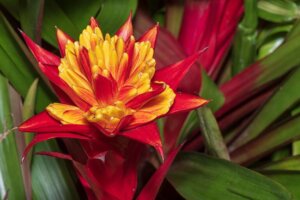Bromeliads: Learn How to Care For and Cultivate Them

Bromeliads are tropical plants with an appearance that absolutely makes you fall in love at first sight. Although people think that their care is complex, this isn’t the case at all. In fact, they require little maintenance and they’re robust plants, so it’s easy to grow them indoors and outdoors.
If you’ve always wanted to have a bromeliad at home, then keep reading! We’re going to give you some tips that’ll make it easier for you to care for it. Take note and enjoy watching your bromeliad develop.
Characteristics and types of bromeliads

Scientifically, they’re known as Bromeliaceae genera and they belong to the Bromeliaceae family, native to West Africa. They stand out for their beautiful foliage. Some of its leaves vary in colors such as red, orange, yellow, purple, and green. For their part, the flowers are usually in shades of red, fuchsia, orange, and pink.
This is a plant that’s epiphytic, which means that it doesn’t need soil as it has the facility to cling to the bark of trees and other objects. So far, more than 2,000 species have been reported, with Guzmania, Neoregelia, Vriesea, and Ananas comosus being the best-known and most common genera in gardens.
- Guzmania bromeliads: species such as G. lingulata, G. zahnii, G. Guzmania sanguinea, and G. monostachia belong to this genus. This type is distinguished by its long and flat leaves, with a bright green hue. The flowers are red, yellow, orange, pink, and purple.
- Neoregelia: a group of bromeliads that are grown indoors. Their leaves are very showy and they go beyond green with pink and purple tones, depending on the species.
- Vriesea: variegated foliage with feather-like flowers. Some of the more popular types within this group are V. splendens and the hybrid Vreisea Fireworks.
- Ananas comosus bromeliads: these are distinguished because they have spidery leaves and a flower spike.
Care and recommendations for growing your bromeliads
Considering that bromeliads are epiphytes, it’s not necessary to provide them with thick or deep soil. On the contrary, the substrate must be composed of a mixture of bark, moss, and organic materials. If you want to grow them in a pot, make sure it isn’t too deep.
In addition to this important recommendation, we’ll also explain the care that you should give your bromeliads below:
Light
Bromeliads like bright light, but in an indirect way. This is especially the case for those variations with rigid leaves and those with soft leaves (and without thorns) should be grown in areas with dimmer levels of light.
However, when the flowering period arrives, you should increase the light exposure, which helps to speed up the process. Although to clarify, this isn’t the only required condition for the flowers to grow well.
Soil conditions
As we’ve already mentioned, the substrate for bromeliads is quite particular. Ideally, you should mix about two-thirds of peat-based soil with one-third of sand. This hybrid makes moisture retention better but facilitates drainage.
Remember, you should also add a little charcoal and moss, among other organic materials. This is similar to soil conditions for orchids.
Another option is to encourage your bromeliads to stick to a trunk or leafy tree, which they’ll really like. In these cases, it’s recommendable to use a support or trellis to help the plant sufficiently cling.
Irrigation

Bromeliads are distinguished because they’re resistant. So much so, that they can withstand drought conditions, despite the fact that their natural environment is humid. As such, it’s not a plant that requires a lot of watering, especially during growth.
At this stage, it’s recommendable to water it sparingly on a weekly basis, while in summer, watering should be increased. Be very careful, as the root of the plant is sensitive and excessive watering can lead to rot.
The best advice we can give you is to touch the substrate before watering, if it’s dry, it’s the right time to water it. When you do water it, take the time to also mist the leaves.
Beware of winter
Although these types of plants are resistant to drought, winter weather can cause them to suffer. The correct temperature for bromeliads is between 60 and 85 degrees Fahrenheit.
In areas with lower temperatures, it’s necessary to protect them. Therefore, when they’re outdoors, grow them in pots, so you can move them inside the house when winter comes.
Cultivation and propagation
The best way to propagate bromeliads is through their shoots, which can be carefully separated and planted. It’s also possible to grow from seed, but this is a difficult method to execute. However, if you want to try, plant the seeds during the winter.
Enjoy your beautiful bromeliads!
Bromeliads are beautiful plants and if you take care of them properly, they’ll steal the show! Follow the simple but efficient advice that we’ve given you and dedicate yourself to watching your home flourish. Are you ready to fill your interior and exterior with color, brightness, and vitality?
Bromeliads are tropical plants with an appearance that absolutely makes you fall in love at first sight. Although people think that their care is complex, this isn’t the case at all. In fact, they require little maintenance and they’re robust plants, so it’s easy to grow them indoors and outdoors.
If you’ve always wanted to have a bromeliad at home, then keep reading! We’re going to give you some tips that’ll make it easier for you to care for it. Take note and enjoy watching your bromeliad develop.
Characteristics and types of bromeliads

Scientifically, they’re known as Bromeliaceae genera and they belong to the Bromeliaceae family, native to West Africa. They stand out for their beautiful foliage. Some of its leaves vary in colors such as red, orange, yellow, purple, and green. For their part, the flowers are usually in shades of red, fuchsia, orange, and pink.
This is a plant that’s epiphytic, which means that it doesn’t need soil as it has the facility to cling to the bark of trees and other objects. So far, more than 2,000 species have been reported, with Guzmania, Neoregelia, Vriesea, and Ananas comosus being the best-known and most common genera in gardens.
- Guzmania bromeliads: species such as G. lingulata, G. zahnii, G. Guzmania sanguinea, and G. monostachia belong to this genus. This type is distinguished by its long and flat leaves, with a bright green hue. The flowers are red, yellow, orange, pink, and purple.
- Neoregelia: a group of bromeliads that are grown indoors. Their leaves are very showy and they go beyond green with pink and purple tones, depending on the species.
- Vriesea: variegated foliage with feather-like flowers. Some of the more popular types within this group are V. splendens and the hybrid Vreisea Fireworks.
- Ananas comosus bromeliads: these are distinguished because they have spidery leaves and a flower spike.
Care and recommendations for growing your bromeliads
Considering that bromeliads are epiphytes, it’s not necessary to provide them with thick or deep soil. On the contrary, the substrate must be composed of a mixture of bark, moss, and organic materials. If you want to grow them in a pot, make sure it isn’t too deep.
In addition to this important recommendation, we’ll also explain the care that you should give your bromeliads below:
Light
Bromeliads like bright light, but in an indirect way. This is especially the case for those variations with rigid leaves and those with soft leaves (and without thorns) should be grown in areas with dimmer levels of light.
However, when the flowering period arrives, you should increase the light exposure, which helps to speed up the process. Although to clarify, this isn’t the only required condition for the flowers to grow well.
Soil conditions
As we’ve already mentioned, the substrate for bromeliads is quite particular. Ideally, you should mix about two-thirds of peat-based soil with one-third of sand. This hybrid makes moisture retention better but facilitates drainage.
Remember, you should also add a little charcoal and moss, among other organic materials. This is similar to soil conditions for orchids.
Another option is to encourage your bromeliads to stick to a trunk or leafy tree, which they’ll really like. In these cases, it’s recommendable to use a support or trellis to help the plant sufficiently cling.
Irrigation

Bromeliads are distinguished because they’re resistant. So much so, that they can withstand drought conditions, despite the fact that their natural environment is humid. As such, it’s not a plant that requires a lot of watering, especially during growth.
At this stage, it’s recommendable to water it sparingly on a weekly basis, while in summer, watering should be increased. Be very careful, as the root of the plant is sensitive and excessive watering can lead to rot.
The best advice we can give you is to touch the substrate before watering, if it’s dry, it’s the right time to water it. When you do water it, take the time to also mist the leaves.
Beware of winter
Although these types of plants are resistant to drought, winter weather can cause them to suffer. The correct temperature for bromeliads is between 60 and 85 degrees Fahrenheit.
In areas with lower temperatures, it’s necessary to protect them. Therefore, when they’re outdoors, grow them in pots, so you can move them inside the house when winter comes.
Cultivation and propagation
The best way to propagate bromeliads is through their shoots, which can be carefully separated and planted. It’s also possible to grow from seed, but this is a difficult method to execute. However, if you want to try, plant the seeds during the winter.
Enjoy your beautiful bromeliads!
Bromeliads are beautiful plants and if you take care of them properly, they’ll steal the show! Follow the simple but efficient advice that we’ve given you and dedicate yourself to watching your home flourish. Are you ready to fill your interior and exterior with color, brightness, and vitality?







